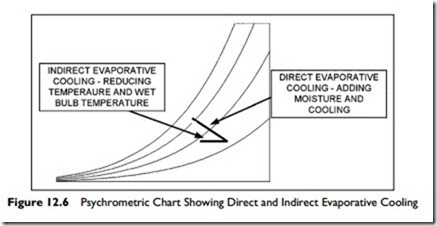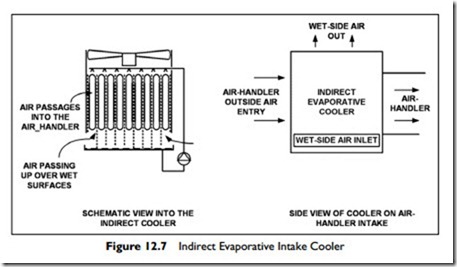Evaporative Cooling
You have been introduced to the idea of evaporative cooling several times so far in this course. In Chapter 2 the process of using direct evaporation was introduced in connection with the psychrometric chart.
Direct Evaporative Cooling
The direct evaporative cooler simply evaporates moisture into the air, reducing the temperature at approximately constant enthalpy. In a hot dry climate this process may often be enough to provide comfortable conditions for people.
In medium to wet climates, the increase in moisture content is frequently not acceptable for sedentary human comfort but is considered acceptable for high effort work places and is ideal for some operations, such as greenhouses.
Indirect Evaporative Cooling
An indirect evaporative cooler uses evaporation to cool a surface, such as a coil, that is then used to cool the incoming air. The indirect evaporative cooler, which reduces both temperature and enthalpy, can be very effective in all but the most extreme conditions. The two processes are shown on the psychromet- ric chart, Figure 12.6.
A previous Figure, Figure 12.5 showed the indirect cooler as the “water-side economizer,” located before the mechanical cooling coil. That is just one arrangement of two-stage cooling.
Figure 12.7 shows an alternative to this arrangement.
In this indirect evaporative-intake cooler, water flows down the outside of
the air intake passages. As it flows down, outside air is drawn up over the water causing evaporation and cooling. The cooled water cools the intake air passages and hence the intake air. This is shown diagrammatically on the left side of Figure 12.7. The unit is mounted at the intake to the air-handler as shown on the right hand side of Figure 12.7.
Depending on the local climate, a unit like this can reduce the peak mechanical refrigeration by 30% to 70% with a very low water and energy requirement from the indirect cooler. The performance may be improved even further if the relief air from the building is used as the air that passes over the evaporative surface.
To quote from ASHRAE 2000 HVAC Systems and Equipment3, Chapter 19:
“Direct evaporative coolers for residences in desert regions typically require 70% less energy than direct expansion air conditioners. For instance, in El Paso, Texas, the typical evaporative cooler consumes 609 kWh per cooling season as compared to 3901 kWh per season for a typical vapor compression air conditioner with a SEER 10. This equates to an average demand of 0.51 kW based on 1200 operating hours, as compared to an average demand of 3.25 kW for a vapor compression air conditioner.”
The main advantages of evaporative cooling include: Substantial energy and cost savings Reduced peak power demand and reduced size of mechanical refrigeration
equipment
Easily integrated into built-up systems
The big disadvantage for evaporative cooling is that many designers don’t understand the opportunity!

